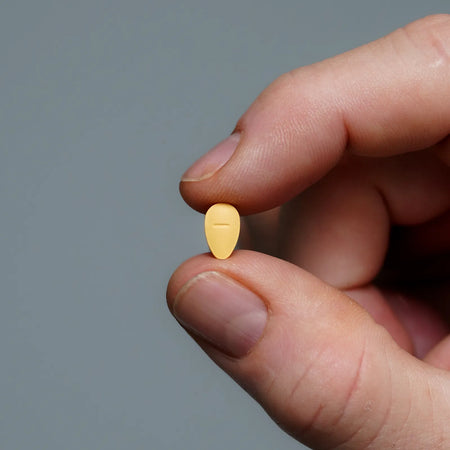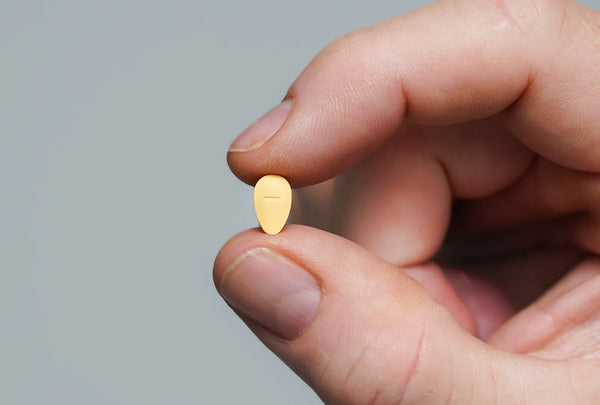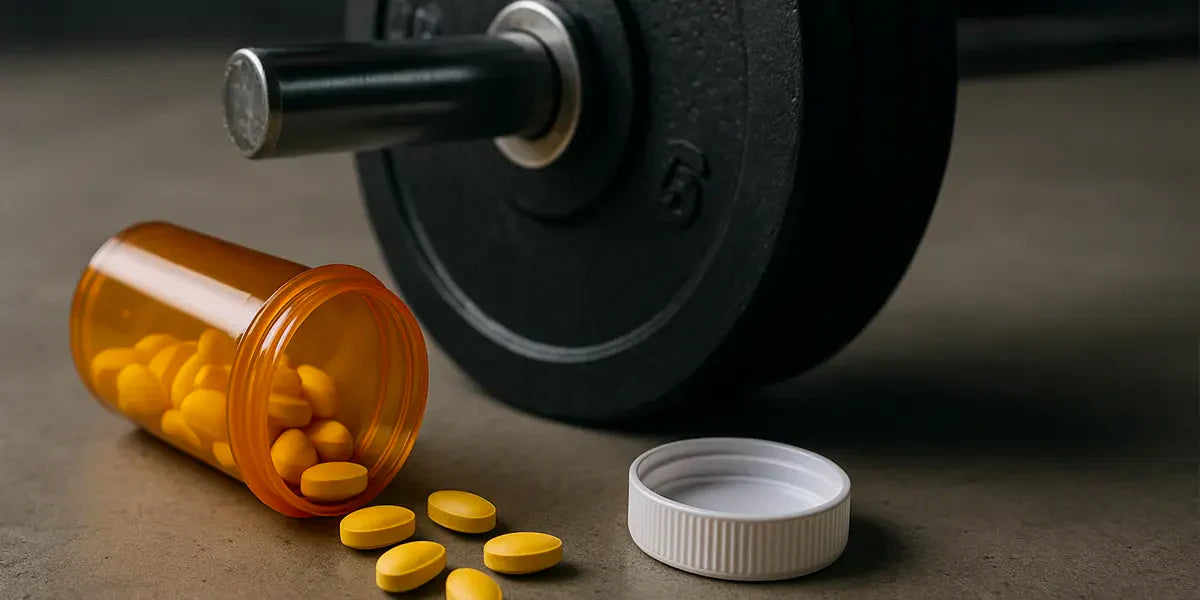Tadalafil is a well-known medication used to treat erectile dysfunction (ED), but it’s gaining attention as a potential muscle growth aid. Before you get too excited, we want to clarify that using tadalafil for these reasons is off label. This means that it’s not FDA-approved for muscle growth or performance enhancement and requires a physician consultation and prescription. Its safety and long-term effects when used for muscle growth aren’t well described in the literature, but it’s worth taking a closer look at some of the studies and data surrounding these claims.


Save on Tadalafil with XYON
Choose the trusted generic option at a lower cost. Start your simple online consultation in just minutes.
What is Cialis (tadalafil)? How does tadalafil work?
Cialis, is a branded version of the generic medication, tadalafil. It’s an example of a type of medication called a PDE5 inhibitor (PDE5i). This type or class of medication is commonly prescribed to treat ED, as well as benign prostatic hyperplasia (BPH) and lower urinary tract symptoms (LUTS). For ED, tadalafil targets penile blood vessels to widen them, which helps to increase blood flow and allow patients to achieve erections sufficient for penetrative sex. It’s helped countless men improve their quality of life through increased sexual and relationship satisfaction.
Tadalafil works by blocking an enzyme called phosphodiesterase type 5 (PDE5), which is found in blood vessels and other parts of the body, and preventing a chemical reaction called hydrolysis from occurring.
Hydrolysis involves using water to break larger molecules into smaller molecules. PDE5 hydrolyzes a molecule called cGMP, which plays a key role in many cellular processes. When you take tadalafil, the medication causes an increase in cGMP levels because the enzyme is no longer able to break it down. cGMP goes on to trigger blood vessel relaxation and other effects.
Can tadalafil help muscle growth?
Potentially. Research has shown that tadalafil can have an effect on body composition and muscle growth. This is because cGMP takes part in various cell signaling pathways including those that control insulin release, change the balance of hormones, and regulate blood vessel function. These processes impact how muscle cells burn and store energy, create conditions that favor muscle growth instead of muscle breakdown, and improve the delivery of oxygen and nutrients to skeletal muscle.
One of the most cited studies on the use of tadalafil for muscle growth found that short-term daily dosing of tadalafil in non-obese men with mild ED and/or LUTS led to an improvement in body composition (increased lean abdominal muscle mass), a higher testosterone to estradiol ratio, and increased insulin production (Aversa et al., 2016).
It’s also been theorized that tadalafil promotes androgen receptor gene expression. In laboratory experiments, the drug seems to increase the number of androgen receptors on muscle cells, which affects how these cells respond to androgen hormones such as testosterone.
Testosterone is one of the most important steroid hormones when it comes to muscle anabolism or building muscle—it's certainly the main hormone responsible for this process in males. Testosterone increases both muscle mass and strength and induces hypertrophy (increases the size) of muscle fibers. Not only that, but the hormone also promotes the development and commitment of stem cells into muscle cells and regulates the breakdown of fats and production of fat storing cells (Wyce et al., 2010). Increasing the number of androgen receptors on muscle cells and subsequent increased testosterone levels could be responsible for more significant muscle gains by making muscle more sensitive to the effects of testosterone.
Tadalafil may also affect the ratio of testosterone to estradiol (a form of estrogen). The ways in which this happens are not entirely clear, but some researchers speculate that in addition to blocking PDE5, tadalafil may also selectively block another enzyme called aromatase that transforms testosterone into estrogens such as estradiol. This could be important to people who want to prioritize lean muscle growth because the ratio of testosterone to estradiol in fat cells can have an impact on fat burning and storage, with overall impacts on body composition and obesity risk (Olasore et al., 2023).
Tadalafil and insulin sensitivity: why it matters for muscle gain
One of the most interesting ways in which tadalafil can influence muscle growth and change body composition is through the release of insulin. The release of insulin is regulated by messaging molecules such as cGMP.
Insulin is a hormone released by beta cells of the pancreas in response to changes in blood sugar, for example, right after you’ve had a meal. It drives the storage of glucose as glycogen in the liver, muscles, and fat tissue (Rahman et al., 2021).
In skeletal muscle, glycogen serves as a major energy source necessary for anabolism (building muscle) by helping move amino acids into muscle cells to create proteins, as well as powering muscle contraction. Insulin has also been shown to inhibit protein catabolism (breakdown), creating conditions more favorable to building muscle overall.
Some researchers have also speculated that by improving blood flow throughout the body and promoting the uptake of glucose, tadalafil and other PDE5is could help combat the effects of insulin resistance, particularly in people suffering from Type 2 diabetes (Lee et al, 2022).
Does tadalafil improve endothelial function for better workouts?
According to clinical studies, tadalafil does seem to improve endothelial function, but whether this directly translates into better workouts remains to be seen. Endothelial function refers to the normal functioning of the smooth muscle cells that make up the inside layer of blood vessels. The endothelium plays a crucial role in how blood vessels narrow or widen in response to stimuli (with effects on blood pressure), as well as blood clotting, and aspects of the immune response such as inflammation. Tadalafil is believed to help with endothelial function by increasing levels of cGMP and another signaling molecule, nitric oxide (NO), within blood vessels (Lan et al., 2025).
It’s important for the endothelium to function properly because it directly affects the delivery of oxygen and nutrients that are needed to support the growth of muscle cells. Additionally, there is a growing body of evidence that points to the role of NO in specific processes that take place in skeletal muscle.
In animal and human studies of subjects with Duchenne muscular dystrophy (an inherited disease characterized by muscle weakness), long-term treatment with PDE5is was shown to improve perfusion (the delivery of blood to target tissues) to muscles during exercise (Kobayashi et al., 2009). Nitric oxide-cGMP signaling has also been proposed as the mechanism behind increased mitochondrial biogenesis, or the increased production of mitochondria, the energy-producing parts of cells. It’s said to be an adaptation to endurance training, which could help delay muscle fatigue and increase glucose uptake (Sheffield-Moore et al., 2013).
In short, use of tadalafil could have positive effects on endothelial function, with benefits for muscular perfusion and other physiological adaptations that could come in handy for athletes, but more data is needed to define what the optimal dosing is and whether any of these effects truly stands the test of time.
What happens to muscle gains after stopping tadalafil?
This is probably one of the more important questions to ask if you’re considering using tadalafil for bodybuilding or to enhance performance. There isn’t a significant body of research dedicated to investigating the use of tadalafil in healthy individuals for the purposes of training and muscle growth. However, one study did look at the effects of stopping tadalafil found that any positive changes in body composition and biochemical improvements (e.g., insulin levels, higher testosterone to estradiol ratio) returned to baseline after two months of not taking tadalafil (Aversa et al., 2017).
The important thing to remember about the study mentioned above is that participants weren’t deliberately working out—in fact, researchers specifically noted that the changes caused by taking tadalafil happened without any changes to diet or exercise. So, it’s difficult to know whether someone taking tadalafil and working out on a regular basis would be able to maintain these fitness improvements long term, or if it’s possible to attribute their gains to tadalafil alone.
Should you use tadalafil for muscle growth?
The jury is still out on whether tadalafil has a role in muscle growth and bodybuilding. Should you use it? You’ll need to talk to your doctor about this because tadalafil does require a prescription, and even then, it’s important to keep in mind that the drug has not been FDA-approved for this purpose. As with any drug, tadalafil can cause side effects, so you’ll want to weigh the decision to take it against other supplements or agents that may have lower safety risk profiles (e.g., creatine, BCAAS, protein powders). These work via different mechanisms to support muscle anabolism, but to be honest, the literature is mixed on how to best use these, and who may benefit the most from supplementation.
Regimented, high-intensity physical activity tends to cause physiological adaptations and when this is paired with the use of supplements, other performance-enhancing agents, and dietary choices that favor muscle growth, it becomes difficult to quantify tadalafil’s contribution.
While there isn’t enough data to strongly support the use of tadalafil for muscle growth or bodybuilding, it does look like there are potential metabolic and endocrine benefits that may be significant for some individuals, such as those living with type 2 diabetes. It’s not clear whether long term daily dosing or on-demand dosing of tadalafil has the same benefits, or what the optimal dosage is. It remains a solid option for treating ED, BPH, and LUTS, but other applications would benefit from further clinical trials.
References:
Aversa, A., Fittipaldi, S., Francomano, D., Bimonte, V. M., Greco, E. A., Crescioli, C., Di Luigi, L., Lenzi, A., & Migliaccio, S. (2017). Tadalafil improves lean mass and endothelial function in nonobese men with mild ED/LUTS: in vivo and in vitro characterization. Endocrine, 56(3), 639–648. https://doi.org/10.1007/s12020-016-1208-y
Kobayashi, Y. M., Rader, E. P., Crawford, R. W., Iyengar, N. K., Thedens, D. R., Faulkner, J. A., Parikh, S. V., Weiss, R. M., Chamberlain, J. S., Moore, S. A., & Campbell, K. P. (2008). Sarcolemma-localized nNOS is required to maintain activity after mild exercise. Nature, 456(7221), 511–515. https://doi.org/10.1038/nature07414
Lan, T.-Y., Chiang, C.-H., Chen, J.-W., & Chang, T.-T. (2025). Potential beneficial impacts of Tadalafil on cardiovascular diseases. Journal of the Chinese Medical Association, 88(4), 267–272. https://doi.org/10.1097/jcma.0000000000001205
Lee, MK., Lee, JH., Sohn, SY. et al. Effect of low-dose tadalafil once daily on glycemic control in patients with type 2 diabetes and erectile dysfunction: a randomized, double-blind, placebo-controlled pilot study. Diabetol Metab Syndr 14, 56(2022). https://doi.org/10.1186/s13098-022-00825-w
Olasore, H. S. A., Oyedeji, T. A., Olawale, M. O., Ogundele, O. I., & Faleti, J. O. (2023). Relationship between testosterone-estradiol ratio and some anthropometric and metabolic parameters among Nigerian men. Metabolism Open, 18, 100249. https://doi.org/10.1016/j.metop.2023.100249
Rahman, M. S., Hossain, K. S., Das, S., Kundu, S., Adegoke, E. O., Rahman, M. A., Hannan, M. A., Uddin, M. J., & Pang, M. G. (2021). Role of Insulin in Health and Disease: An Update. International Journal of Molecular Sciences, 22(12), 6403. https://doi.org/10.3390/ijms22126403
Sheffield-Moore, M., Wiktorowicz, J. E., Soman, K. V., Danesi, C. P., Kinsky, M. P., Dillon, E. L., Randolph, K. M., Casperson, S. L., Gore, D. C., Horstman, A. M., Lynch, J. P., Doucet, B. M., Mettler, J. A., Ryder, J. W., Ploutz-Snyder, L. L., Hsu, J. W., Jahoor, F., Jennings, K., White, G. R., McCammon, S. D., … Durham, W. J. (2013). Sildenafil increases muscle protein synthesis and reduces muscle fatigue. Clinical and translational science, 6(6), 463–468. https://doi.org/10.1111/cts.12121
Wyce, A., Bai, Y., Nagpal, S., & Thompson, C. C. (2010). Research Resource: The androgen receptor modulates expression of genes with critical roles in muscle development and function. Molecular Endocrinology (Baltimore, Md.), 24(8), 1665–1674. https://doi.org/10.1210/me.2010-0138




